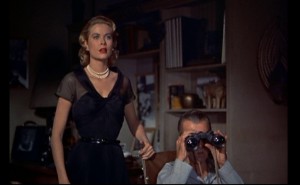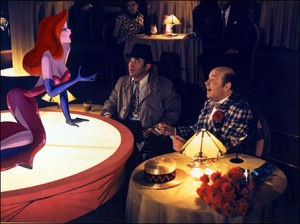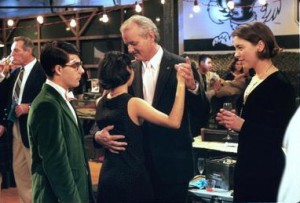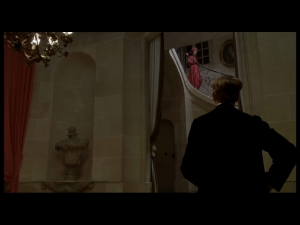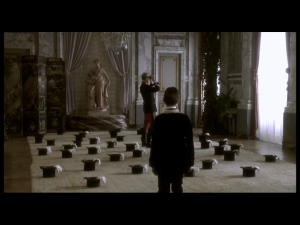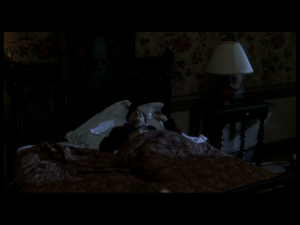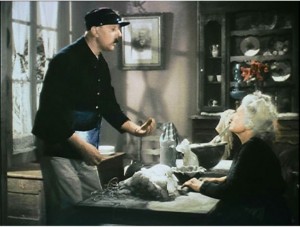The concluding chapter of my book Movie Wars: How Hollywood and the Media Limit What Films We Can See (Chicago: A Cappella Books, 2000). Due to the length of this Conclusion, it’s being posted in two parts. — J.R.
Q: In Chapter Five, you argue that the cable channel Turner Classic Movies does a more responsible job of preserving our film heritage than the American Film Institute, citing what they’ve recently done in “restorations, revivals, documentaries about film history, and even in presenting foreign-language movies.” Of course TCM has vastly more economic and material resources at its disposal than the AFI does, which suggests that big business versus state funding isn’t always the enemy.
A: Yes, and I’d stand by that comparison — although I wouldn’t go so far as to claim that TCM has any sort of edge over the Cinémathèque Française, especially when it comes to varied and knowledgeable programming of world cinema (which includes certain categories like experimental film that TCM completely ignores). I had to wait for years in Chicago before I could get TCM, and friends of mine in New York and Los Angeles had comparable problems. Now that we have it, it’s certainly a boon to get the sort of balance between structured and unstructured programming of older films that the Cinémathèque has often specialized in. The structured programming allows you to explore certain directors, stars, and genres in depth, the unstructured programming allows you to make your own discoveries. I also applaud the sort of initiative TCM has taken in showing silent and foreign‐language films, in showing everything without commercial breaks and almost everything without cuts, and in presenting letterboxed versions of widescreen films that enable you to see them in their original formats. Not that they always have a perfect record. One of the films
I almost included in my list of the hundred greatest American films is Jacques Tourneur’s Cinemascope western Wichita (1955), and the main reason why I omitted it is that I’ve never been able to see it in a ‘Scope format — something I suspect I could have done if I was living in Paris. This morning (June 12, 1999) I thought I’d finally get a chance because TCM programmed it, but then I
discovered that they were showing only a scanned version, something they also did a few days ago with Anthony Mann’s ’Scope western The Last Frontier, made the same year. I assume you know what scanning is: a camera rescans the original image so it can fit the less rectangular TV screen, eliminating about a third of the image and also adding cuts in order to get from one side of the frame to the other.

Lamentably, the ’Scope films of masters of composition like Tourneur and Mann get mangled almost every time they’re seen on TV or video, which practically speaking is almost the only way you can see these films. However, Chris Fujiwara, in his definitive recent critical study Jacques Tourneur: The Cinema of Nightfall (2), calls Wichita Tourneur’s only major work in Cinemascope and devotes over a page to his compositional uses of that format.
I don’t know how to account for such lapses on TCM, given their usual track record; maybe they couldn’t locate the right elements that would enable them to show Wichita and The Last Frontier properly, or maybe they simply didn’t bother. But they’re still miles ahead of BRAVO, which recuts practically everything it shows, as well as American Movie Classics, which is much more selective about what it chooses to letterbox. It’s true that Ted Turner got a bad rep when he embarked on colorizing some of the black‐and-white films in his collection back in the eighties — a fad that I’m happy to say never wholly caught on, although the widespread misunderstandings of the technical and legal issues involved clouded the fact that he was already getting involved in film restoration by striking new black‐and‐white prints in order to carry this project out. There’s a wonderfully astute and lucid essay about these contradictions and misunderstandings by Stuart Klawans, “Rose‐Tinted Spectacles,” that I’ve already quoted in this book’s introduction. Let me quote a later paragraph that has particular bearing on some of the issues of this book:
Now, it is a matter as negligible as a producer’s heart whether the people who were fighting against colorization had a deep understanding of classicism. It does matter, though, that they got so wrought up about their hallucinations that the fantasy, having taken on a life of its own, came to dominate the debate. It did so, I would suggest, because of a fundamental trait of our society: Americans have no commonly accepted terms in which to ground their arguments about artistic endeavors and moral rights. Our society has never acknowledged the civic importance of either category; and so public discussions that touch on those issues will almost inevitably take off into the clouds. (3)
This is where the practical as well as philosophical superiority of an organization like the Cinémathèque Française comes in: although it has its own set of problems, its work derives from a public mandate about artistic endeavors and moral rights that can’t be found in American society. Given that we currently have to make do with what we have, I don’t think any “French solution” to our muddled film culture is feasible, but at least it offers a useful model of how another society can cope with some of the same problems.
Q: Maybe you’re not proposing a “French solution,” but there are certainly times in this book when it appears that you are. In fact, the encroachments of Francophilia in your arguments seem to increase as this book develops. You start off by addressing the American situation, even though you keep bringing up references to people like Jean‐Luc Godard. Then in Chapter Seven you sound off about American coverage of the Cannes Film Festival, and by the time you get to Chapter Nine you’re recycling stuff you’ve written for a French film magazine. Isn’t there something snobbish and elitist about this kind of emphasis, shot through with genuflections towards an intellectual film culture that couldn’t be further from American interests? I’m reminded of the complaints of Howard Hampton when he reviewed your last book in Book Forum: bristling at your snide definition of “homeless people” as “those without computers or TV sets,” Hampton goes on to note parenthetically, “I suspect Rosenbaum’s solution to the problem of the homeless and orphaned movies would be to bring them together, housing the poor in theaters holding all-night Jacques Rivette screenings.” (4)
A: The snideness of my ridicule of Newt Gingrich, which I thought I’d adequately signaled by placing “homeless people” in quotes, is only connected to my support of Jacques Rivette by a loose analogy of what gets overlooked and ignored. I’d never dream of suggesting that Rivette belongs in the mainstream, and what drove me to hyperbole in that instance was the fact that Rivette’s greatest and in some ways most accessible work — a thirteen‐hour serial made in 1971 — has still never been shown or seen in the United States. And to give you some idea of how blocked we are, when Anthology Film Archives attempted to show a complete Rivette retrospective in 1996, after the programmer tried and failed to get hold of a print of the thirteen‐hour Out 1 that had been subtitled in English for a screening in India, he refused to let me furnish my own unsubtitled video for a public screening. Yet paradoxically, the desire to see it even in unsubtitled form was still so strong that the first hour or two on video got shown anyway, unofficially, when some Rivette freak offered to screen it. A handwritten announcement of the screening was posted in Anthology’s lobby, but the event had to be kept a secret from the retrospective’s programmer, who was adamant about not allowing it to be shown, so of course it couldn’t be advertised either. That’s an extreme and somewhat comic illustration of the kind of obstacles some minority interests are up against — the fact that it’s apparently easier to see Out 1 in India than it is in this country. Why should it remain so impossible? I’m perfectly willing to let the studios do their thing on a massive scale as long as my friends and I are allowed to go off in a corner and do what we want to do as well. But this can only happen if middle management allows it to, and they prefer to proceed as if only the studios exist.
As for my Francophilia, the fact that my own self‐education in film history was largely carried out in Paris when I lived there for five years (1969–74) obviously plays some role in this. But I can’t deny that most of the issues discussed in this book are also matters of great concern in the French film community, where worries about “Americanization” and the overall dumbing down of film culture are equally prevalent. Sometimes the yardsticks of measurement being used are quite different, but sometimes they’re more or less the same, particularly when multicorporate interests are involved. The Economist just reported that even though over eight million French viewers went to see Asterix and Obelix Take On César — “a film based on a French comic strip about plucky Gauls who resist the mighty Roman empire” — during the first two months of its run, twenty‐one million French viewers have seen Titanic. To me what’s surprising is not the latter figure, but the large number of people there who went to see a strictly non‐Hollywood feature.
In some ways I’m even more concerned about the overall dumbing down of a magazine like Cahiers du Cinéma — which was recently purchased by Le Monde, but which became much more market‐conscious in its orientation years earlier. It still operates on a much higher level than Film Comment or Film Quarterly in
terms of what it covers, but it no longer can be considered a critical trailblazer, as it used to be in the fifties and sixties — it tends to coast on its earlier reputation. As a film monthly it’s roughly on a par with Positif, its long‐term competitor, but in many ways I prefer the extensive film coverage of the Parisian weekly Les Inrockuptibles, which supposedly concentrates on rock but actually has lively coverage of all the arts, including literature. And the French magazine I write for most often, Trafic — a quarterly with no illustrations (apart from a small one on the cover) that costs about twenty bucks an issue, and currently has a circulation of about two thousand — has no parallel of any kind in the states either. It may sound about as marginal as a film magazine can get, especially because it has no American distribution apart from a few scattered subscriptions, but in fact it gets cited all the time in the French mainstream press, especially in newspapers like Libération and magazines like Les Inrockuptibles, so it has a definite cultural impact. People as diverse as Jean-Luc Godard and Gilles Jacob, the director of the Cannes Festival, read it regularly.
As for including some of my writing for Trafic, which is concerned with many of the same questions and issues, I thought it might be useful to broaden the scope of the discussion by factoring in the sort of material that usually gets elided from American books for market‐driven as well as ethnocentric reasons. Just as the autobiographical side of my writing is often here to show where my ideas and opinions are coming from, it’s useful to give English-speaking readers some notion of what sort of French readers I’m addressing on occasion.
The usual unvoiced premise is that the film cultures of this country and France are so disparate and sui generis that they might as well go on muttering to themselves rather than attempt to communicate with one another. Yet this premise is contradicted repeatedly by my own experience; what transpired at the the Cannes press conference on She’s So Lovely is directly relevant to what I say about publicity and about Miramax elsewhere in the book, just as the technical difficulties in enabling people to see Rivette films in Manhattan, De Oliveira films in Providence, and Farocki films in Locarno are all interrelated. And one of the advantages of allowing readers to eavesdrop on discussions that usually take place outside their earshot is that it allows some recognition of a wider playing field. Maybe that’s elitist, but I’d rather regard it as sharing the wealth. I’ve been unusually fortunate in having some access to film culture beyond American borders, and to omit any acknowledgment of that access would be condescending to American readers — like censoring what one says at a party because children are present.
Q: Let me rephrase my objections. It seems that you’re seesawing back and forth in this book between journalistic reports and critical overviews. Moreover, there’s a certain contradiction in claiming that the mass audience is right — which you tend to do in the critical overviews — and making particular pitches for your specialized interests, most of which couldn’t possibly interest the mass audience.
A: I certainly plead guilty to the charge of mixing criticism with journalism and reviewing. I make my living as a journalist, and one of the drawbacks of that profession is writing for the moment, which makes broader and more balanced views much more difficult to arrive at. The seesawing pattern you’re describing is certainly there, and it’s up to the reader to decide whether this helps or hinders this book’s agenda. I’d like to think that alternations between overall battle plans and particular “reports from the front” help to develop the argument by testing theory with practice and generalizations with specific cases. But it’s also true that reading about films one isn’t likely to see and hearing about events that have lost their journalistic immediacy can make the overall process of following an argument something of a slog. All the critical overviews in this book have been arrived at through experiences “at the front,” but it’s always worth considering which experiences are most instructive to read about.
As for the apparent contradiction between my defense of the audience and my defense of certain “specialized” films, I can only reiterate that the kind of film culture I’m arguing for is one that allows all sorts of interests to coexist. Every critic is limited by his or her taste, and if I don’t appreciate L.A. Confidential, Saving Private Ryan, or Election as much as Denby does, that doesn’t mean I don’t respect the mass audience; I also happen to like City Lights, To Have and Have Not, Rear Window, Who Framed Roger Rabbit, The Apostle, Small Soldiers, and Rushmore, which are every bit as mainstream.
(By the way, I liked The Apostle even more before October Films decided it had to be shortened and recut — a job that was handed to Walter Murch, whom I had the good fortune of working with on Touch of Evil. Murch’s reedit was carried out after a few reviewers wrote from festivals that the film would be better if it were shorter. I don’t know if October based its decision to shorten the film on those reviews, but it’s hard to believe there was no connection. Anyway, despite the fact that Murch did an excellent job, it seems horrifying that reviewers who see a film once can theoretically wind up as the final arbiters of a movie that a filmmaker — in this case Robert Duvall — has spent many years working on, and this is far from being an isolated instance of this practice. When the documentary Waco: The Rules of Engagement turned up in Chicago in a version that bordered on gibberish, I discovered that it was cut by half an hour after a Variety review from Sundance suggested it would benefit from pruning; I haven’t see the longer version, but it’s hard to imagine it was as difficult to follow. And I certainly have no doubts that Taste of Cherry suffered when it wound up being distributed throughout Italy without its final sequence — again
because of well‐wishers who decided that they knew more than Kiarostami did. Perhaps the most telling example that springs to mind, furnished to me by Australian film critic Adrian Martin, is the screening of Irma Vep without its own final sequence on Australian TV due to a lab error; when the film was subsequently revived on Australian TV with its original ending, the publicity for it boasted it was the “restored” version!)
***
Q: You argue that ordinary moviegoers might become more interested in subtitled movies if the industry gave them more opportunities to see them. But you seem to be avoiding the massive anti-intellectualism and xenophobia of American culture, which isn’t going to disappear anytime soon.
A: Fair enough. It’s a sobering thought that the Times just hired two young Pauline Kael fans to replace Maslin, both of them defined in part by their relative lack of interest in non‐American movies, and one of them a literary critic with no background of any kind in film. So it isn’t surprising that the latter thinks that Stranger Than Paradise was Jim Jarmusch’s first feature and that the other reviewer recently referred to “Dogma 95” as a Dutch film movement. (The odds of
fact-checkers spotting errors of this kind in the Times, judging from their former track record, are just about nil.) In fact, I think we can safely conclude by now that the Times is profoundly committed to the notion that anyone and everyone can be a film “expert.”
But I’d also like to think that their power to determine what foreign films can get U.S. distribution may at long last be drawing to a close. I can’t prove it, but there are definitely signs of an improving climate, including many more initiatives from distributors. For instance, just as this book is going to press, a Chicago colleague,
Patrick McGavin, forwards me what he considers “the best news of the year, moviewise,” a press release announcing that Kino International is opening Râùl Ruiz’s Time Regained — an extremely sophisticated and imaginative 155-minute adaptation of Proust, light-years beyond anything one could expect from Merchant- Ivory — in Manhattan in June, despite the sour notice it got from Maslin at the New York Film Festival. I don’t think this would have been possible a few years ago. In fact, the correspondence I get nowadays from readers — such as a teenager in London who monitored how the Ruiz film did when it opened there earlier this year (he says it wound up in fifth place the first week, even though it puzzled audiences), and who e‐mailed me this information because he thought I might be interested — convinces me that there’s a growing community of people who care deeply about such matters. And if the Times turns out to be one of the last places on the planet to get this message, there’s nothing new about that, either.
I remember an anecdote from my early high school days in Alabama; it’s funny how, with every passing year, the small‐town thinking and behavior of Manhattan reminds me more and more of what I grew up with in Florence, Alabama. A friend who was attending Sunday school there in the fifties reported back one day that the church he went to was just having a debate about whether or not it was evil to learn foreign languages — at which point one of the participants volunteered, “All I can say is, if English was good enough for Jesus, it’s good enough for me.” I can’t really claim that attitudes of this kind don’t exist — even if the New York spin on these attitudes is to feel classy rather than country‐smart about its worldly wisdom. Another notable difference: whereas a high school kid from Alabama might think that Jesus speaks English, someone like Denby, considerably more urbane, merely thinks that God watches Hollywood movies. (I’m recalling his review of JFK for New York magazine: “Even God would be frightened by this movie.” Just the sort of insight needed at the Times, which, after all, decided that Oliver Stone’s showmanship — unlike all the preceding years of investigations into the Kennedy assassination — made conspiracy theories worthy of coverage on the front page.)
Which leads me to a working assumption of this book that may be unduly optimistic, although I hope it isn’t. When I speak in favor of Americans having more access to world cinema, my working assumption is that most Americans — or at least a substantial number of Americans — want to be citizens of the world. I even think that the common belief that Americans are xenophobic isolationists by nature is partly the self‐serving invention of Hollywood publicists armed with millions of dollars who don’t want to clutter up their precious ad campaigns with thoughts of other tastes and cultures. But if they’re right — if the public’s overwhelming desire
is merely to regard people outside the United States as failed Americans — then world cinema can’t consist of anything but a failed attempt to make American movies.(5) And if we really are primitive and solipsistic enough to believe that, then I’m afraid this country deserves the limited kind of movie choices it gets. A more logical step might be to ban foreign movies entirely since these can only distract us from our national purpose.
In other words, art is a way of becoming better acquainted with the world and we have reasons for wanting to improve our knowledge on this front. But one thing that apparently differentiates this country from all others is that art is actively hated by a good many of its citizens; de Tocqueville has some sobering thoughts to offer on this subject. But at the same time, one of de Tocqueville’s chapter headings could serve as one of the mottoes of this book: “The Example of the Americans Does Not Prove That a Democratic People Can Have No Aptitude and No Taste for Science, Literature, or Art.”
It’s interesting to reflect on how frequently these negative American attitudes are ied to class prejudices. More often than not, the moviegoer who hates the very idea of subtitled movies also hates the idea of cappuccino and brie, classical music, opera, and ballet — the whole complex of what’s regarded as hoity-toity, fashionable upscale pretensions, which are commonly associated with Europe — whereas most of the foreign‐language movies that exist in the world, European and otherwise, are every bit as populist and commercial in orientation as the stuff that comes out of Hollywood studios. At the same time, as Jim Jarmusch points out, members of the working class in Europe don’t feel obliged to regard art with contempt and suspicion the way that many of their American counterparts do.
___________________________________________________________
[5] To be fair, Denby’s version of this formula is slightly different — that Kiarostami’s work consists of a failed attempt to replicate Satyajit Ray and Vittorio De Sica, an Iranian who wants to be Indian or Italian rather than American. This ignores all of Kiarostami’s formal innovations while faintly implying that filmmakers who make movies about poor dark-skinned people must be serious in other respects.
The misperception of foreign movies is produced, of course, by the way they’re packaged and sold and often discussed in the media. Back in the sixties, most Bergman films were associated with espresso in the lobby and high‐class soul‐searching about the meaning of life; Woody Allen still perpetrates that stereotypical notion about art movies in practically everything he says and does, which is one of the many reasons why I tend to mistrust the middle‐class attitudes in his work. Even worse, he’s transferred part of that class‐bound ideology to his notion of the American art movie. Some people find Interiors just as objectionable as Bergman, for virtually the same reasons — I remember the reception it got at a mall theater in Florence, Alabama — but others find it less objectionable simply because it’s in English. I would argue that it’s the latter group that the industry has been catering to over the past few decades, re-enforcing some of these biases in the process. On a larger scale, the same sort of thing happened when critics and audiences started going bananas over American genre movies dressed up in art-movie clothing — The Godfather, The Deer Hunter, and Ordinary People are three examples among many others. Then people began to conclude that if American directors could be just as “artistic” as foreign directors, there was no good reason why sub-‐ titles had to clutter up our lives.
Furthermore, one of the things that made Last Year at Marienbad an arthouse sensation for a brief period in the sixties was the swanky settings and Delphine Seyrig’s Chanel dresses, not just the formal play with narrative film conventions. The fact that Alain Resnais and to some extent Alain Robbe-Grillet, the screenwriter, were also playing with and parodying certain Hollywood tropes went over the heads of most American viewers — although Dwight Macdonald certainly got the point. (Even he apparently missed the life‐size blowup of Alfred Hitchcock lurking in the hotel lobby and the shot‐by‐shot recreation of a sequence from Gilda in one of the bedroom scenes, but he caught the allusions to Marlene Dietrich and Josef von Sternberg in some of Seyrig’s poses.)
The big theater chains lost a golden opportunity when they failed to show Run Lola Run, an edgy and highly entertaining German youth movie, in malls across the country. I can’t believe that American teenagers would have refused to check out a movie they would have loved simply because it was subtitled. Other teenagers around the world didn’t respond that way when it was shown subtitled in other languages, and I can’t believe American teenagers are so radically different from their counterparts elsewhere. The problem is that exhibitors are locked into outmoded and self-defeating premises and no one ever thinks of challenging or even questioning them.
Such biases are the product of conditioning, and there’s no reason why the Woody Allen or the Francis Ford Coppola model of the American art film have to be the only ones available. Miramax has virtually proven this point with its handling of Life Is Beautiful, and even if I don’t happen to like that film, I can’t deny their ingenuity
in selling it to a wide public. As Stuart Klawans recently put it in The Nation, “Miramax does well with uplifting fare, such as Life Is Beautiful (feel good about the Holocaust!), Shakespeare in Love (feel good about Shakespeare!) or Kids (feel good that you’re not one of those rotten kids!).”
The marketing of certain Hong Kong films in the United States provides another model, although in that case there’s still a bit of confusion about what Hong Kong filmmaking consists of. As I suggest in Chapter Seven, John Woo’s Face/Off is far from being the same thing as his Bullet in the Head, but that doesn’t prevent the media‐industrial complex from trying to foster the vague impression that it is.
In theory, the cappuccino notion of the art movie, a protracted hangover from the late fifties and early sixties, still holds, but in actual practice the possibilities are astronomically wider. Lovers of the Arctic Circle, to take a recent example, has some of the play with narrative form associated with something like Last Year at Marienbad yet none of the chi‐chi décor and costumes, and that didn’t stop it from finding an urban audience. Might it have found a suburban and small‐town audience as well? Given our present setup, we have no way of knowing, because unless a distributor with the muscle of Miramax decides to give it the Life Is Beautiful treatment, it’s not going to get into those malls. There’s reason to think that Jour de fête, based on its commercial success in other countries, might have worked at malls even better than Lovers of the Arctic Circle, but it never got commercial runs in more than a couple of American cities, and even in those situations it received no fanfare at all.
Q: You’ve been parceling out most of the blame for this on exhibitors and distributors, but what about the critics and the media as a whole?
A: One of my basic points is that distinguishing between the priorities of distributors and exhibitors and those of the critics and the media in general is almost impossible. And rather than ascribe this to any conspiracy I’d blame it on laziness and inertia. You might say that Miramax’s steamrolling has more energy and initiative behind it than any of the media responses to that steamrolling, including the responses of critics. As I put it four years ago, “The fault, dear Brutus, is not in Miramax but in ourselves, that we are their underlings.”
We have to break loose from the crippling ideology that insists that movies function as a business not only first and last, but in between as well — leaving no room for the rest of us who care mainly or exclusively about the art. A case in point is The Wind Will Carry Us, Abbas Kiarostami’s latest feature, which won the jury prize at Venice and made such a powerful and exhilarating impression on me a few days later in Toronto that I went to a second screening of it the next day and felt I was walking around inside it for the remainder of the week. More metaphorical and elliptical and closer to comedy than Kiarostami’s previous feature, Taste of Cherry, it can’t be called one of his easiest pictures, and some viewers emerge from it puzzled. (I was one of them, but it was a very happy and fruitful form of puzzlement.) Set in a remote and ancient village, where a carload of men from Tehran — apparently a documentary film crew — wait for an ailing woman who’s about a century old to die, it further develops Kiarostami’s notion of an interactive cinema where the spectator’s imagination plays a central creative role in the proceedings; at least half of the major characters, including the old woman and most of the crew, remain off-screen. What seems relatively new to Kiarostami’s work is a focus on nature and a moral questioning of media.
For me there’s no greater film artist at work anywhere right now than Kiarostami, who at this point makes precisely the movies he wants to make with precisely the modest budgets and crews he requires and reaches substantial numbers of spectators across the globe who love these movies and consider them important facts in their lives. What better situation could any artist hope for? But read about the 1999 Venice Festival in Variety and you discover it was dull because there wasn’t more wheeling and dealing. Start talking to industry specialists about The Wind Will Carry Us — even those who say they revere Kiarostami — and you’ll encounter a lot of sorrowful head‐shaking because it isn’t his “breakthrough” or “crossover” movie. For me, this is like saying it’s too bad Robert Bresson never got to make a film with John Travolta. What they’re worried about, in other words, isn’t how good or beautiful or important it is but whether or not it will allow some American suits to turn a profit.
Poor old James Joyce — condemned to be a cultural nonperson by slaving away at Finnegans Wake when he could have signed on as a feature writer for Vanity Fair or even TV Guide and thus gotten at least one foot in the door, leading to the possibility of . . . what? A Book of the Month Club selection, a sale to DreamWorks, a spot on Larry King? Why, for that matter, did William Faulkner waste his time with Light in August when he could have tried for a “crossover” triumph instead, something along the lines of John Grisham or Stephen King?
It’s this ludicrous sort of reasoning that characterizes the majority of the current American press — as one can readily see by looking at the movies awarded annual prizes by most critics’ organizations, in contrast to the award-winners at Cannes and Venice. But it doesn’t necessarily characterize the majority of the American public, who can’t be blamed for missing Kiarostami movies as they zip through town if practically everything in the media and culture insists that Kevin Costner and Kevin Smith movies are thousands of times more important, simply because they’re American.
Q: So how do we set about changing things?
A: A good first step would be discovering where we are and what sort of things are being done on our behalf — the way we’re being stereotyped as audience members. Then a second step might be behaving as an audience member in a way that refutes and confounds those stereotypes — although this requires more initiative than the first step, at least in conducting research about what’s around and then acting on that information. It also means following your own initiatives instead of mine — although you may want to use “marginal” critics like myself and some of my colleagues as part of your research.
As for putting so much trust in estimates of box‐office grosses over the opening weekend of a film’s run, everyone has to stop being so gullible and trusting — and that includes a lot of journalists as well as ordinary filmgoers. In the December 20, 1999 issue of the Los Angeles Times, Richard Natale quotes one unidentified studio executive who admits that this is largely “a game of liar’s poker.” As Natale goes on to explain:
Trouble is, the preliminary figures, gathered by the studios and released on Sunday morning, are imprecise and sometimes deliberately exaggerated, yet they have supplanted the real weekend grosses as a measure of a film’s initial success.
In recent weeks, the box-‐office grosses for such films as The World is Not Enough and Pokemon have been estimated at more than $1 million over their final opening weekend figures.
Natale goes on to cite many more creative miscalculations, and adds:
Even when the figures don’t vary that much, they can be padded as part of a jockeying game for a more favorable position. On one weekend in mid-October, the Sunday estimates placed Paramount’s Double Jeopardy in first place, Universal’s The Story of Us in second and Fox’s The Fight Club in third. By Monday, the final numbers revealed that Fight Club had been the biggest grosser, followed by Jeopardy and The Story of Us.
There’s been an interesting evolution over the course of the past half‐century in the press’s trust in both the federal government and the entertainment industry. When I was a kid, I don’t think anyone entirely believed what the movie studios said, but most people and it would be interesting to try to figure out how such an astonishing reversal came about.
***
We need to redefine film criticism. Limiting it to the evaluation of features that turn up in multiplexes is self‐defeating for reasons I don’t have to enumerate. What would our literary criticism be if it were restricted to paperbacks carried by K‐Mart? If anything, the massive advertising campaigns of the multinationals need to be countered, not merely supplemented, and countered by a lot more than skeptical reviews. The working assumption of the press now — that all interesting and important movies are uniformly available, or else that they cease to be interesting or important the moment they become unavailable — is that the public is too stupid and impotent to think for itself about such matters, so that it becomes the job of publicists and reviewers to shoulder that responsibility.
For that reason, I’ve argued elsewhere, in my collection Placing Movies (Berkeley: University of California Press, 1995), that we’d be much better off if we had no film critics at all. Barring that possibility, we could certainly use a few who respect the people who read them.
Beyond that, your guess is at least as good as mine, because the way things are going now, audiences aren’t supposed to have voices, only automatic reflexes and wallets that the media‐industrial complex interprets as voices. But learning how to speak and how to be heard is the third and most important step — if only because it puts you on an equal footing with the filmmakers.
How can this be done? If I gave you an answer to that question I wouldn’t be respecting your own initiative very much. I’d rather hear from you about it.












